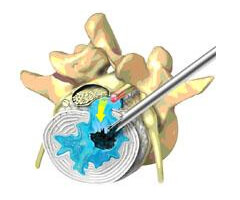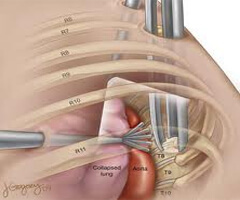Definition of Intradiscal Percutaneous Procedures
Disks that perform the function as cushions between the bones of the spine can sometimes get damaged and protrude onto nerves, causing back and leg pain, weakness, and numbness. These therapies use thermal energy sources to treat diskogenic low back pain caused due to annular tears. These procedures are crafted to decrease pain arising from the annulus and enhance its structural reliability. The heat-induced denaturation of collagen fibers in the annular lamellae may stabilize the disk and potentially seal annular fissures, and that pain reduction may occur through the thermal coagulation of nocioceptors in the outer annulus. Another procedure, referred to as Percutaneous Intradiskal radiofrequency thermo Coagulation (PIRFT), uses direct application of radiofrequency energy. With PIRFT, the radiofrequency probe is placed into the center of the disk and the device is activated for only 90 seconds at a temperature of 70 degrees centigrade. The procedure is not designed to coagulate, burn, or ablate tissue. The Radionics RF Disk Catheter System has been specifically designed for this purpose.

A more recently developed procedure, referred to as Intradiskal Biacuplasty (Baylis Medical, Inc., Montreal, Canada), involves the use of two cooled radiofrequency electrodes placed on the posterolateral sides of the intervertebral annulus fibrosus. It is believed that by cooling the probes a larger area may be treated than could occur with a regular needle probe.
Procedure of Intradiskal Percutaneous Procedures
- Disk Nucleoplasty-Disk nucleoplasty is a significant medical advancement in the treatment of contained herniated disks. Because of its new technology, disk nucleoplasty is a minimally invasive procedure Disk nucleoplasty, officially called percutaneous disk nucleoplasty, sends pulses of radio waves into the nucleus of a herniated disk. These radio waves vaporize small amounts of disk material, creating an empty space within the disk. The material that has bulged out of the disk wall will then move to fill in this empty space, restoring the disk wall to its original shape. With the disk wall no longer herniated, the pressure on nerve roots or the spinal cord will disappear, providing immediate pain relief.
- Introdiskal Electro Thermal Therapy-IDET is a minimally invasive procedure used to relieve chronic or severe low-back pain caused by diseased, damaged, herniated or degenerated disks. IDET involves the application of an electrothermal catheter, a thin heating wire, which delivers precise amounts of heat to a disk. This allows the physician to shrink or seal any tears or cracks in the outer wall of the disk, reduce the bulge of inner disk material known as a herniated disk, and cauterize (burn) and thereby disable painful nerve endings affected by the deformed disk.
- Dekompressor Disketomy-It is a non-surgical, effective treatment for back and neck pain associated with herniated disk disease. The pain relief associated with this therapy is due to decompression of the spinal disks and facet joints, thus reducing the pressure exerted onto the spinal cord and nerve roots causing pain. Percutaneous Diskectomy uses a single-use probe called the "Stryker Dekompressor" which is placed under x-ray guidance. Once the area is numb, a larger needle is placed into the affected disk with x-ray guidance. The probe is placed through this needle and the procedure is initiated. You may feel pressure during this part of the procedure, but should not experience pain. The Dekompressor uses a pump method to remove excessive disk material from bulging or contained herniated disks, thus reducing pressure in the disk and providing pain relief. There are further two types of disk decompressions as

Percutaneous mechanical disk decompression
Decompression is a procedure in which the surgeon removes some of the tissues from the center of the bulging disk that is causing pain. The objective is to remove as little material as possible, so that the disk remains stable. It is a minimally invasive procedure. The surgeon makes use of a needle to reach the disk and remove the extra material from the gelatinous center of the disk (known as the nucleus pulposus). It is usually done under local anesthetic in a doctor's office. Although your movement may be limited for a while after the procedure, healing is faster than with an open surgery.

Planning your medical trip to India is a very simple process with Spine and Neuro Surgery Hospital India
- You just need to fill in our enquiry form and one of our executive will contact you soon.
- +91-9325887033 Call us at the given to contact number for any assistance.
- Complete information regarding surgery is provided on our website.
Laser disk decompression
Another treatment takes some of the fluid out of the disk that is causing pain. Laser treatments have been used to deflate a disk somewhat. This is a minimally invasive procedure. The doctor inserts an optical fiber into the disk. The heat created takes out a small amount of the center of the disk. The heat may reduce pain by affecting the chemical structure in the disk.
Advantages
- As the surgery gets over within an hour and no major incision is done the patient can go home that very day.
- Speedy recovery
- Significant pain relief.
- Quantifiable disk material removal.
- Low complication and morbidity rates.
Complications
- The most common complaint is mild back pain at the injection site shortly after the procedure.
- Other more serious and far less common complications include spinal cord compression, excessive intracranial pressure, bleeding, hematoma, or infection.
Precautions
- You should apply periodic ice on the treatment area 1 to 2 hours per day for 3 days.
- Plan on bed rest with gentle stretching for 1 to 3 days. Limit sitting or walking to less than 30 minutes at a time.
- Prescriptions or non-prescription pain and anti-inflammatory medications may be required for 3 to 30 days.
- A stretching program under the direction of your physician, physical therapy, and chiropractic care should begin after 7 days.
- Plan on conservative physical activity for up to 3 months.
- Back braces or supports are not necessary but may improve your recovery.
- Your physician may recommend other specific post-procedure instructions.

Prognosis
- The reduction in pain allows patients to experience enough relief to become active again.
- Often patients regain the ability to resume their normal daily activities. If you are suffering from chronic back or neck pain contact Arizona Pain Specialists today to see if you can benefit from this advanced treatment.
Want to have a FREE Consultation for your Intradiscal Percutaneous Procedures Treatment in India?
We will give you best surgeons for taking best and safe treatments at an affordable low cost. Post a query and get a quick response
Click Here